Indoor air quality is a thing that should be on everyone’s mind but unfortunately that is not currently the case, which has a bunch of consequences as a result. In this extensive article, we’ll talk about everything related to the topic.
It will affect your health and comfort if the air quality is low in the places that you’re commonly in. There are certain pollutants you should be looking out for and consequently trying to avoid if possible. We’ll walk you through them here.
Are you ready?
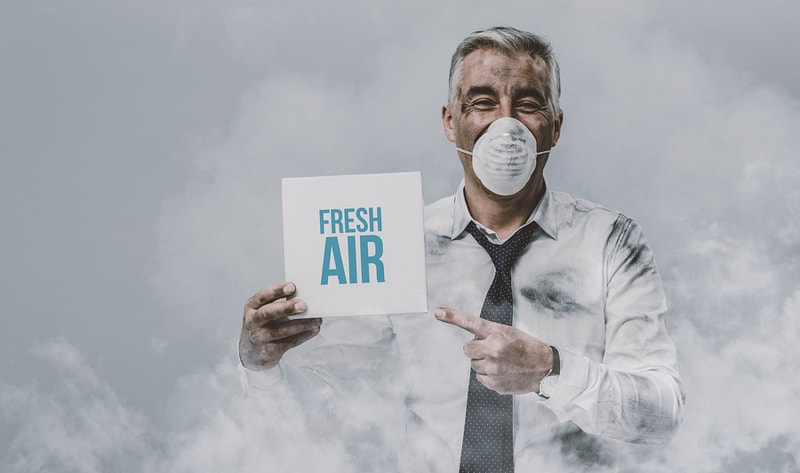
Effects of Indoor Air Pollution on Human Health
There are both short-term and long term effects of poor indoor air quality and high levels of pollution when it comes to your health, and some of these effects can sometimes be seen relatively shortly after being exposed to the pollutants.
Here are the short term effects that you may be experiencing:
- Dizziness
- Fatigue
- Headaches
- Irritations of throat, nose and eyes
- Coughing
- Sneezing
- Respiratory congestion
- Coughing
Be on the lookout for these things, especially as you’re entering or leaving a specific place. Having these signs show up could be a sign that you either just entered or left a place that has a lot of pollutants and poor indoor air quality. The different contaminants may also be more likely to cause certain effects than others.
If you think you have either influenza, a cold, stress or allergies, it could in fact be caused by pollutants also.
You may also be more or less likely to be experiencing these problems depending on your age or whether you have a pre-existing condition such as asthma. Asthma can be significantly worsened in such cases. Some people are a lot more sensitive to the air quality than others, and you may become more sensitive after time and repeated exposure too.
It can be hard to determine whether your above symptoms are in fact due to the air quality since they look so much like common things you could contract too.
What Are Some of the Long Term Side Effects Caused by Indoor Air Pollution?
There are also long term side effects that can be caused by poor indoor air quality, and these include a range of things including cancer, heart disease and respiratory diseases. Even if you are not experiencing any of the above symptoms, it’s still a good idea to actively be thinking about what you can do to improve air quality.
Since people react so differently to exposure, some people may develop serious problems while others will not.,
What Causes Bad Indoor Air Quality and Pollution?
While poor outdoor air quality is more a focus with a lot of cities having worryingly high levels of pollution, there are things inside your own home that cause bad indoor air quality too. Smog outside is not the only thing you should be worried about. If it’s really bad, your home’s air quality could in fact be a lot worse than the air outside. You’re likely to think about all the fumes outside and how they’re lowering the quality of the air, so it can be hard to imagine that your home has such substantial problems.
Automobiles, factories and ozone are all problems outside, but a lot of the same things causing problems with them could be giving you health problems at home.
Is Ozone Harmful: Its Health Effects
Yes, ozone is harmful and will influence the air quality. The same way that it is found outside and is one of the things measured to generate the AQI, it is also used in certain things that you might in fact be using inside that can be harmful to you. One of its health effects is that it can damage your lungs, and it can worsen a range of different diseases.
While it may affect people differently, it’s by no means healthy to inhale.
The Contaminants in Your Home
There are a lot of sources of contaminants that make it into your home, and these include dander, cleaning solvents, fungi, viruses, pollen, dust and more too. Although they may be so small that you are unable to see them, they could be causing problems to your lungs and overall health. Open windows may be enough to let them into your home, and it’s not a joke that you should be actively seeking to remove dust.
Pets will also bring a lot of them into the house, and you probably know a person or two that are either allergic or sensitive around different furry animals.
Mold and bacteria are other things you should be concerned about. Mold does especially well in high-humidity environments which is another reason why you should make sure to monitor possible sources of high humidity. It’s also expensive to remediate once it’s there, so you’ll want to be proactive in your approach.
Perfume, paints and cleaning supplies will also bring in a lot of these contaminants. Read our article on how to use vinegar to clean your home.

A lot of the contaminants are easy to eliminate simply by changing your habits slightly. Some of the other pollutants that we will cover in this article include:
- Radon
- Ozone
- Tobacco
- Particulates
- Biological pollutants
- Pesticides
- Outdoor air pollution
- Mold
- Allergens
- Carbon monoxide
- Carbon dioxide
- VOCs
- Legionella
- Formaldehyde
- Bacteria
- Asbestos
Conserving Energy vs Keeping Your Home Healthy to be in Due to Poor Ventilation
You’ve always been told that you should try and turn off the light to save energy, but did you know that in our efforts to save energy and better insulate homes, we’ve created a problem with poor ventilation? With a lack of airflow, all the contaminants get to stay where they are and become a problem for the quality of the air. Ventilation is needed to get them moved out of the house.
Be Vary of High Humidity
High humidity will be a problem for a number of reasons, including the fact that they are good for the development of mold. If you have problems with humidity in your house you may want to consider getting a dehumidifier installed too.
Contrary, extremely low levels of humidity could also be causing various problems such as squeaking floors, because it dries out the wood causing it to shrink. When the humidity then increases again, the floors expand and over time this causes them to loosen.
The Ideal Level of Humidity
Humidity is generally advised to be kept between 35-55% in your home. It keeps your furnishings from drying out, it keeps mold from developing and it is simply ideal for a lot of different reasons.
One advantage to not lowering your humidity below this point is that more humid air feels warmer than drier air, and that lowers your need to heat the house during those colder months.
Where Does Poor Indoor Air Quality Rank as an Environmental Threat?
The potential effects of poor indoor air quality is such a big problem that the EPA actually ranks it among the top 5 environmental risks to public health which kind of shows how significant of an issue it is.
Top 5. I bet you didn’t think it was that much of an issue. While you may be wanting to lower your energy bill, understandably,in doing so the air quality also tends to suffer due to the effects on ventilation. Anything that creates additional air barriers will have an effect on these things.
There are many of them, but better airflow will improve the situation. Did you know that dropped ceiling actually makes the air in your home worse with its ability to reduce air flow? If you do take measures to lower your energy consumption by sealing off your home, make sure to ensure that there’s still good ventilation.
What Are VOCs (Volatile Organic Compounds) and How do They Affect Air Quality?
You may have heard about VOCs before. The name standing for Volatile Organic Compounds. These are things you should be looking to limit your exposure to since they’re emitted as gases from certain products. They inclue a lot of different chemicals and they’re likely to have health consequences as a result of extended exposure.
When you’re outdoors, the number of VOCs you’re exposed to is significantly less than indoors. Outdoors, there may only be a tenth of the VOCs you will be exposed to indoors.
It’s not just when you’re using these products that the release of VOCs can be a problem, it can also be when they’re simply stored. Wax, paints, finishes, cleaning products and more may all be problematic things containing them.
Aerosol sprays, automotive products, air fresheners, pesticide and more are among the list of things you should be looking for since these can be problematic.
If you’re using any of these products, fresh air is the best way to limit your exposure to VOCs. A thing such applying Polyurethane to your wooden floors is also a significant source of VOCs, especially if you’re using the oil-based one.
Is Formaldehyde a VOC?
Yes, Formaldehyde is a VOC, and actually one of the best known ones. The advantage with it is also that it can actually be actively measured. When that’s been done, you should aim to remove the source of it. A sealant may be applied to stop the VOCs when removing the source isn’t a possibility.
When there is a lot of humidity in the air in your home, this can cause products containing formaldehyde to release it into the air, which does nothing good for the air quality. Your throat, nose and skin could easily be affected from this release.
Reducing Your Exposure to Damaging VOCs
There’s a bunch of ways you can limit the amount of VOCs in your home, and limit your exposure when you will be forced to use products known to emit organic compounds.
- Make sure there’s proper ventilation when these products are being used.
- Use a respirator when doing things such as painting your home to limit your exposure.
- Always follow the precautions on the products and consider taking additional steps to protect yourself.
- Unused paints should be properly stored when the container has been opened. You probably know that it has a lot of smell to it, and it just so turns out that inhaling it isn’t healthy.
- Avoid using pesticides if you can and figure out natural ways to prevent pest infestations from becoming a problem.
- Containers of product containing organic compounds should either be thrown away or be properly stored when they have been opened. Try to avoid buying cans that you know will sit around opened for a long time.
- Make sure that kids and pets are unable to get to problematic products such as the ones mentioned.
Surprisingly, it’s only in industrial settings that standards have been created with relation to VOCs.
Asbestos
Asbestos is another one of those products that could potentially do nothing good for your home’s indoor air quality. It’s been widely used in a range of different products, although its use has been limited. Asbestos siding is a popular type of siding on older homes, and while it has a bad reputation for the problems it can potentially bring, it doesn’t always.
It does add a lot of good qualities to building materials, but when airborne, causes a lot of problems in return. As long as it’s secured and no particles are in the air, it poses no problems. When it’s either being cut, sanded or otherwise affected so that its particles may escape into the air, that’s when it becomes dangerous. Needless to say, removing the product should be done by a pro.
Biological Pollutants
There are also biological pollutants that can affect the air you breathe. Here are the most common sources.
- Contamination in your HVAC system causing mildew or mold.
- Rats and mice leave potent allergens too that can end up being inhaled and cause problems. Check out our guide on getting rid of rats and the one on getting rid of mice.
- Pollen
- Viruses
- Mold
- Bacteria
- Pets (because of their animal dander and saliva)
- Cockroaches and other pests such as rodents
Take active steps to remove these from your house and you’ll be well on your way to better health.
How to Test Air Quality in Your Home
By now you may be starting to wonder how you go about figuring out whether poor air quality is in fact a problem in your home or not, and what additional steps you may be taking to improve the quality of that delicious stuff you’re breathing in every moment of the day.
To start off with, there are a bunch of steps that you can take that will help you in testing the quality of the air in your home, and many of them are even really quite simple.
Air Quality Monitor
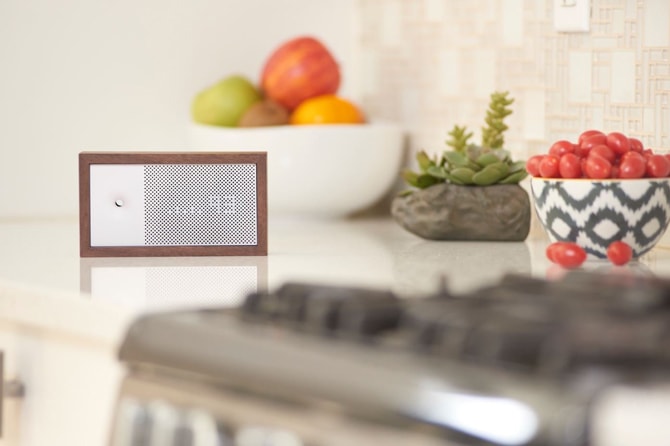
Start out by buying an air quality monitor. They don’t need to be too expensive, and they can help you make sure that you don’t air quality problems in your home. They can detect when something is off and can also show you development over time too.
In order to get a good, reliable device you might need to pay $150, although your health will than you for this.
Are You Seeing Mold?
Simply being aware of visually looking for mold is a good idea. A musty smell can easily be an indication that you have a mold problem. Black spots, Water spots, and damp areas will indicate there is or could start growing mold. Be sure to watch out for water leaks, including roof leaks, that could all cause problems with mold.
Make Sure Your Carbon Monoxide Detector Works and That There’s One on All Floors
You won’t be able to see or smell it, which is why a lot of homeowners underestimate the problems it can cause. It can be made by a range of appliances in your home, include grills, furnaces, fireplaces and more. Although it should be placed on all floors, it’s especially important to put one next to your bedroom that will wake you up if you’re sleeping.
You should also follow the recommendations provided by the manufacturer in order to make sure it doesn’t stop working.
Radon
It’s an important step to test your home for this type of radioactive gas. The easiest way is to have a professional come out and test it for you.
Air Quality Testing Companies
You can also get the help of air quality testing companies that can do all of this for you and find any problematic sources of pollutants and help you deal with them.
Their recommendations will obviously be better than the recommendations that you will get from simply installing a monitoring device. They can help you look for different things including:
- Combustion particles
- Problematic cleaning products
- VOC containing air fresheners
- Allergens and dust particles that are lowering the air quality.
- Paint in your home that contains lead.
What is An Air Quality Alert and What Does it Mean For You?
We breathe all the time and rely on oxygen to keep us alive, yet you have probably heard of air quality alerts. Although they’re not inside your home necessarily, outside elements will also impact your inside air. However, given your obvious interest in air quality since you have gotten this far in the article, we thought we’d also cover air quality alerts too.
Particulate matter and ground-level ozone are the two things that will determine whether these alerts are issued or not. Pollutants like cars will cause ozone-levels getting dangerously high on the ground.
Wood smoke, ash, soot and dust are the things that go into particulate matter. Burning of fossil fuels will cause these levels to rise and will be worse when it’s hot and humid.
Air quality alerts are generally divided into three different categories, each with their own meaning. If there’s even a maroon or purple warning, this is the most serious warning and that means that all groups are affected. They’re also the most rare ones.
It starts getting dangerous for all categories when a red air quality alert is issued, while an orange one is relevant for people that are more sensitive to bad air quality.
When these warnings are issued, you should generally try and stay indoors and not simply blast your windows open, as that will lead to the problematic air getting inside. In places with serious air pollution, face masks are sometimes used.
Air Quality Index
The Air Quality Index (AQI) is an index for measuring how polluted or clean air is, and it is also what the alerts we previously talked about, are based on. It goes from 0 to 500, with the lower scores indicating cleaner air. A score of 0-50 indicates the air quality is good, 51-100 means it’s moderate, 101-150 means it will affect sensitive groups, 151-200 makes the air unhealthy for everyone, 201-300 is very unhealthy, 301-500 is hazardous.
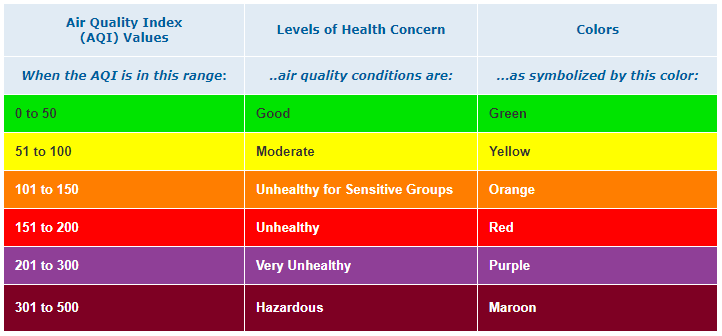
Photo credit: airnow.gov
This chart indicates the different levels of health concern and their corresponding colors.
So Where is the Worst Air Quality in the US in General?
While air quality varies day by day, some cities in the US are notoriously having worse air quality than others – here are the worst ones. This list was taken from CNBC.
- Los Angeles
- Bakersfield, CA
- Visalia, CA
- Fresno, CA
- Sacramento, CA
- San Diego, CA
- Modesto, CA
- Phoenix, AZ
- Redding, CA
- New York
How Can You Improve Indoor Air Quality?
There are many different things you can do to improve the indoor air quality, that range from including plants in your home decor and changing your habits slightly, looking for alternative products with lower levels of organic compounds.
Best Indoor Plants for Air Quality

There’s a bunch of plants that will help filter out VOCs in your home, and having some of them will help improve the quality of your air. Here are the best indoor plants that you should be getting, and you can even put them there even if the air quality seems satisfactory.
- Aloe vera
It helps remove benzene and formaldehyde from the air, and then the leaves and gel can also be used for a range of good things too.
- Peace lily
They help remove both trichloroethylene, benzene and formaldehyde. They’re also just stunning.
- Heart leaf philodendron
You should avoid this if you have any family members such as pets or kids that might be tempted to try and consume it since it’s poisonous doing so.
- Bamboo palm
The great thing about it is that it doesn’t even need much sunlight to grow.
- Chinese evergreen
Another plant that doesn’t require massive amounts of sunlight and is easy to keep. What a treat!
- Warneck dracaena
Those oils and varnishes used for your hardwood floors won’t be as damaging to your health with this plant helping you out.
- English Ivy
It’s great again formaldehyde!
- Azalea
It also feeds on formaldehyde and look beautiful with its pink flowers.
- Weeping fig
Using carpet in your home is not the most environmentally-friendly option you can go with, and they also tend to be bad for the air quality, but this plant can help.
- Red-edged dracaena
These are great for your air’s quality and even bring in some color too.
- Chrysanthemum
These are also beautiful, colorful flowers that will help your home be a little safer to be in.
- Golden pothos
Problems with Formaldehyde will be less when you bring this plant into your home.
- Snake plant
Formaldehyde will not get a quiet moment when you introduce this plant into your home. Put it in the bathroom since it likes moisture and doesn’t need much light either.
- Gerbera daisy
Removing trichloroethylene is what it specializes in.
- Spider plant
This is a very resilient plant that also helps your indoor climate.
Cleaning Your Air Ducts
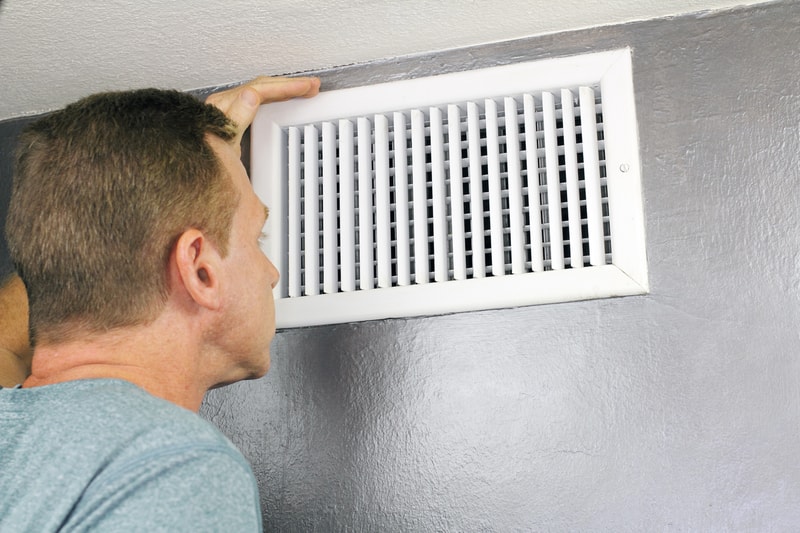
Mold and different things can stem from your air ducts too which is why it’s a good idea to have it cleaned when you have concerns related to its cleanliness.
Carbon Monoxide Levels
Make sure you’re keeping those carbon monoxide levels down since you can’t easily detect it. There are different steps you can take to do just that.
- Properly adjust and maintain appliances that make this gas, such as boilers, furnaces and stoves.
- Space heaters should ideally be vented
- Avoid idling your car before using it since it creates unnecessary carbon monoxide
- Have your HVAC unit inspected by a pro
- Use a wood stove that meet EPA emission standards.
- Make sure you’re using the exhaust fan when the gas stove is on.

Using Air Cleaners, Purifiers and Air Filters For the Home
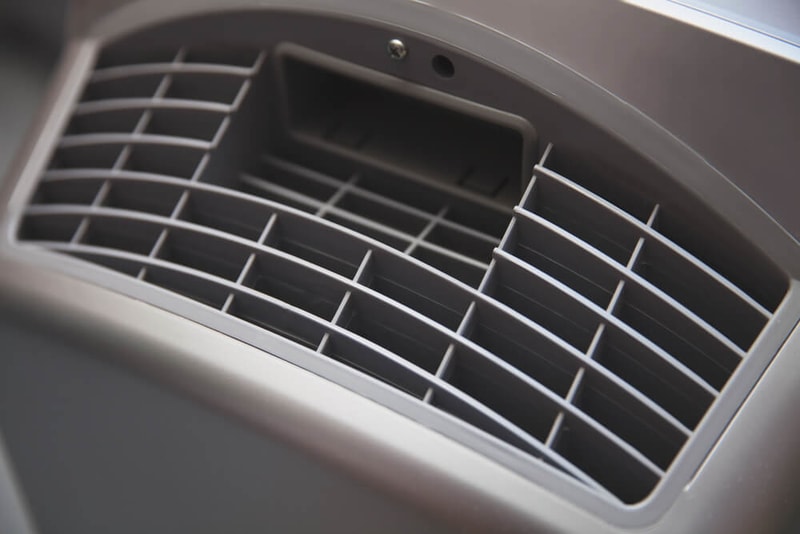
If you’re suffering from allergies, you should install an air purifier in your bedroom, and it should do wonders for you. Get an electric one that provides better assistance in cleaning the air. It’s also important that you change the air filters according to the specifications of the manufacturer. For people that are sensitive to the quality of the air, they should usually be changed every 20-45 days. When you have pets, the general recommendation is every 60 days and otherwise every 3 months.

You can also benefit from reading our article on general home maintenance too.
Using Natural Cleaning Supplies
Your natural options are many when it comes to cleaning supplies, so why not use one that doesn’t in fact damage your health. It’s a very easy habit to change.
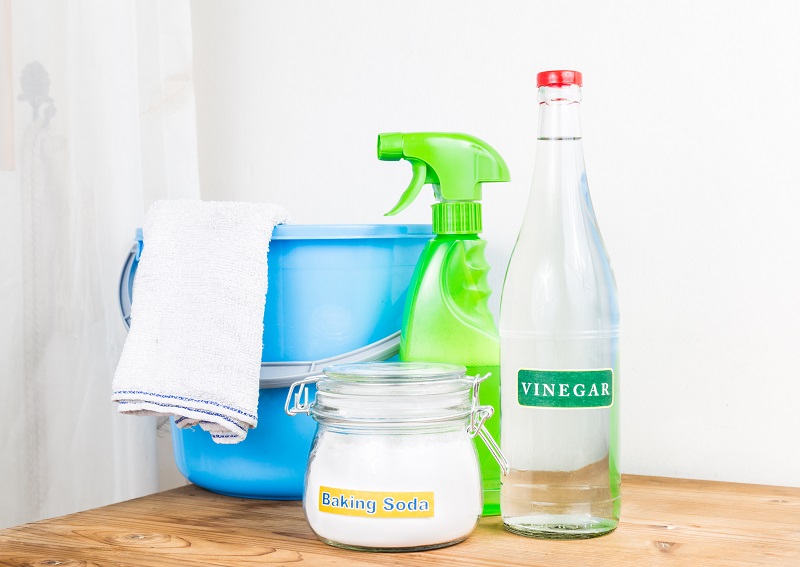
Get Your Mattress and Carpets Cleaned Regularly
Your mattress and carpets are both places where dust and other things can accumulate without your knowledge. By getting them cleaned, you’re helping protect your health too. Your bedding should also be washed at regular intervals.

Avoid Smoking Inside
If you have a habit of smoking, don’t do so inside as it does just the opposite to improving the air quality. It also causes a range of potential different problems such as lung cancer, even for people exposed to secondhand smoke.
Go With Non-Toxic Paint and Avoid Oil-Based Polyurethane
There’s a difference in how much products will emit VOCs, and paint and Polyurethane are two places where changing can really make a difference.
Bathe Your Pets Even if They Don’t Like it
It won’t just keep them from dragging in dirt, it will also keep the air quality better in doing so.
Non-Scented Products Contain Less Things That Will Damage Your Health
Deodorants, air-fresheners and other things all contain toxic chemicals to give them their desirable features. Choose natural options to help your health.